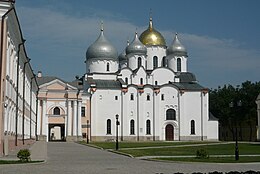Historic Monuments of Novgorod and Surroundings
| UNESCO World Heritage Site | |
|---|---|
 | |
| Location | Veliky Novgorod, Novgorod Oblast, Russia |
| Includes |
|
| Criteria | Cultural: (ii), (iv), (vi) |
| Reference | 604 |
| Inscription | 1992 (16th Session) |
| Coordinates | 58°32′N 31°17′E / 58.533°N 31.283°ECoordinates: 58°32′N 31°17′E / 58.533°N 31.283°E |
 Location of Historic Monuments of Novgorod and Surroundings in European Russia | |
Historic Monuments of Novgorod and Surroundings is a composite World Heritage Site which includes a number of medieval monuments in and around Veliky Novgorod, Russia. The site was inscribed in 1992.[1]
History[]
Novgorod between the 9th and the 15th centuries was one of the most significant cities of medieval Rus. It lay on the trade route from the Varangians to the Greeks and was the center of the Novgorod Republic, which included the major part of what is currently northwestern Russia. From the 12th century, it was an example of a medieval republic, in which decisions were taken by veche – a meeting of the city population – and the prince was elected. (The only other Russian city with a similar organization was Pskov.) Novgorod was one of few areas of Rus not affected by the Mongol invasions, and therefore, in particular, active ecclesiastical construction was continuing in Novgorod in the 14th century, while it was stale in the rest of Rus. Novgorod was as well the seat of archbishop and an important cultural center. The earliest known Russian manuscripts were produced in Novgorod in the 11th century. Russian whitestone architecture and Russian painting originated from Novgorod and Pskov. One of the most important Russian medieval painters, Theophanes the Greek, was active in Novgorod.[1]
Composition[]
The following monuments have been including to the site and are part of World Heritage,[2] Many of the objects are operated by the .
- Soil laid out between the 9th and the 17th centuries;
- Chamber of Facets, officially listed as the ensemble of Novgorod Kremlin, 1433;
- The ensemble of the Yaroslav's Court;
- Ramparts and moat of the , 14th-16th centuries;
- The of the , 16th century;
- The Saint Nicholas Church on Lipno Island, 1292;[3]
- The Nereditsa Church, 1198;
- Ruins of the , 12th century;
- The ensemble of the Peryn Skete;
- The ensemble of the Antoniev Monastery;
- The , 1406;
- The , 1367;
- The on Shirkova Street, 13th century;
- The Yuriev Monastery;
- The Zverin Monastery;
- The (14th century);
- The , 1407;
- The of the , 1312-1313;
- The , 1454-1455;
- The Annunciation Church at Lake Myachino, 1179;
- The , 1422;
- The , 1463-1464;
- The Church of Saint Peter and Saint Paul in Sinichya Gora, 1185-1192;
- The , 1553;
- The , 1526;
- The , 1374;
- The , 1520;
- The with the bell-tower, 1462;
- The , 1360-1361;
- The , 1380;
- The ;
- The , 1557;
- The , 1536;
- The , 1383-1384;
- The , 1379;
- The , 1557;
- The , 1300.



A 12th-century fresco from the Antoniev Monastery
References[]
- ^ a b "Historic Monuments of Novgorod and Surroundings". UNESCO. Retrieved 15 April 2012.
- ^ Перечень памятников истории и культуры г. Великий Новгород и его окрестностей, имеющих выдающуюся универсальную ценность, включенных в 1992 году Решением юбилейного заседания Комитета Всемирного наследия ЮНЕСКО в Список Всемирного наследия (in Russian). Комитет культуры Новгородской области. Retrieved 16 April 2012.
- ^ "Church of St Nicholas-on-the-Lipno". The Church Gazette. Retrieved 27 October 2012.
- Historic Monuments of Novgorod and Surroundings
- Tourist attractions in Novgorod Oblast
- World Heritage Sites in Russia






